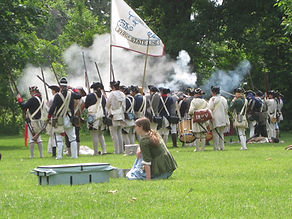

17th REGIMENT of LIGHT DRAGOONS


Death or Glory Boys
The American Revolution and the
His Majesty’s Government sent two regiments of light dragoons to serve on the continent during the War. We were the first and the longest stationed unit, since we would remain in America for the next eight years, serving in almost every single major campaign till hostilities ended. In October 1776 we were joined by our brothers in arms, the 16th Light Dragoons until they returned home in 1779.
As time has a way of doing, the 17th had not been under the command of its founding Colonel for some time by the outbreak of rebellion in the colonies. John Hale had been appointed Governor of Limerick and the colonelcy was passed on to Colonel George Preston of the Scots Greys, another cavalry regiment, on the 2nd of November, 1770.
George Preston had held a long and distinguished career in the Army, having fought and been wounded in the War of Austrian Succession as well as suffering the same career in the European fronts of the Seven Years War. By the time he took command of Hale’s Death or Glory Boys, he was 63 years old and still ready to continue fighting for King and Country.
In the years leading up to the war, Preston’s Dragoons in Ireland had been given a reputation as dedicated, disciplined horse-soldiers. And so when hostilities looked like they would boil over into a flaming rebellion, the 17th were the first cavalry corps to be called to action in the New World during this rebellion.
The 17th embarked from Ireland towards the end of March in 1775. A crossing from Europe to the Americas by ship was an endeavor that was not for the faint of heart. A voyage in good weather would take at least six weeks, and that’s if everything was, quite literally, smooth sailing. Depending on the time of year, some voyages could take up to 3 months before reaching the colonies.
To make logistics even more troubling, moving men and stationary goods was one thing; transporting horses across an ocean is an entirely different matter. The method for securing large livestock across oceans in ships hadn’t changed much since the days when America was first discovered by Europeans. Horses would have to be loaded below decks for the duration of the voyage, often strapped to a sort of hammock that girded their belly and hobbled their legs to limit their movement while the ship rocked and swayed. Mortality levels for these animals were high and even unloading the beasts after weeks of muscle atrophy was dangerous to the men and animals.
After a harrowing two months, the 17th and their surviving mounts landed at Boston on the 24th of May, 1775, only weeks after a small group of local militia clashed with British Regulars outside of the occupied capital city. With them came three generals aboard the HMS Cerberus; William Howe, John Burgoyne, and Henry Clinton. With the reinforcements arriving by the day, the Royal Forces within the city swelled to around 6,000 troops, including the almost 300 Dragoons of the 17th.
Their welcome into the Royal Colony was less than appreciated by the local inhabitants. Tensions rose as the irregular militias began to flock to the outskirts of the city, barricading and choking off the Royal Forces and harassing Sir Thomas Gage and his martial government within the city. Within weeks of the initial conflict, the city was under siege and Gage was determined to break it.
About four weeks after their arrival in the New World, the Death or Glory boys would see their first major action in the war, but it certainly wouldn’t be their last.
17 Jun 1775
25th Aug 1776
28 Oct 1776
1st May 1778
April 1780
Battle of Monck's Corner
April 14, 1780
Battle of Cowpens
January 17, 1781